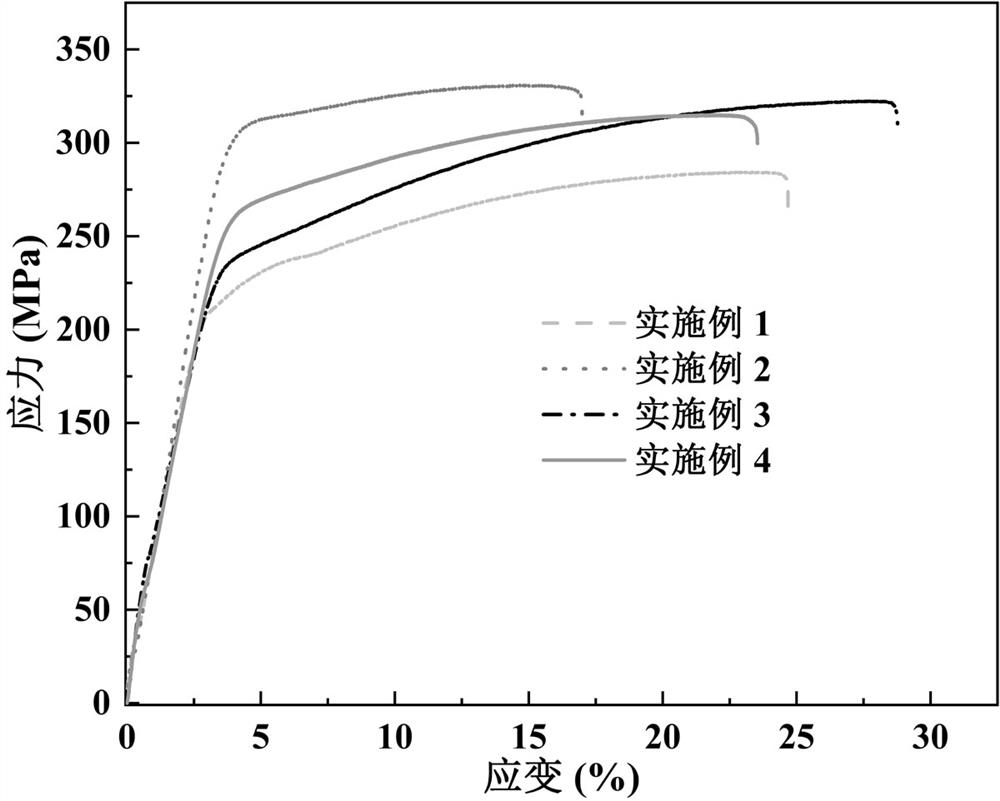A Differential Hot Forming Method for Preparation of High Strength and Toughness Magnesium Alloy
A magnesium alloy and differential heat technology, applied in the field of magnesium alloy materials and their deformation processing, can solve the problems of rare earth elements increasing the cost of alloy preparation and unfavorable wide application of alloys, so as to improve the efficiency of alloy preparation, precisely control the microstructure, and improve the quality of alloys. performance effect
- Summary
- Abstract
- Description
- Claims
- Application Information
AI Technical Summary
Problems solved by technology
Method used
Image
Examples
Embodiment 1
[0047] Example 1: Take the equal channel corner extrusion deformation as an example, the specific steps are as follows:
[0048] (1) Ingredients: The alloy raw materials are high-purity magnesium ingots (99.95%), high-purity zinc ingots (99.995%, 50 mm), high-purity tin particles (99.99%, Φ2×5 mm), and Mg-30 wt.% Zr master alloy. First, weigh the original material slightly higher than the alloy composition, and then polish its surface oxide film (except for high-purity tin particles) to a clean and non-oxidized surface and the same quality as the composition (error less than 0.01 g), and finally clean the original material , dry for use;
[0049] (2) Preheating: Preheat dried magnesium ingots, high-purity tin particles, zinc ingots and Mg-30 wt.% Zr master alloy at 200-250 °C for 30-35 min. In addition, the stainless steel crucible and the stainless steel casting mold for smelting are all preheated and kept at this temperature for standby use;
[0050] (3) Smelting and casti...
Embodiment 2
[0054] Embodiment 2: In this embodiment, steps (1), (2), (3), (4) are the same as those in Embodiment 1.
[0055] The difference between this example and Example 1 is that the alloy obtained in step (4) is subjected to four-pass differential thermal iso-channel corner extrusion deformation. At room temperature, the alloy sample and the equal-channel corner extrusion die were coated with high-purity graphite mixed with a small amount of synthetic oil at the same time, and then only the extrusion die was heated to 300 °C, and the alloy sample was not heated. When the temperature was stable, the temperature was kept for 30 min; after the heat preservation, the room temperature alloy sample was put into the mold for four passes of extrusion deformation. The extrusion speed is 12 mm / s, the channel turning angle is 120°, and the deformation path is the Bc path. After the extrusion was completed, the sample was air-cooled to room temperature to obtain a four-pass deformed alloy. Th...
Embodiment 3
[0056] Embodiment 3: In this implementation, steps (1), (2), (3) are the same as those in Embodiment 1.
[0057] The difference from Example 1 is:
[0058] (4) Heat treatment: The as-cast alloy obtained by (3) is subjected to heat treatment, including solution heat treatment and aging heat treatment. The solution heat treatment process is to keep the as-cast alloy at 400 °C for 12 h, and then put the sample into 25 °C clean water for quenching to obtain a solid solution (T4) alloy; the aging heat treatment process is to heat the solid solution alloy at 300 °C. Heat-treated (T6) alloy was obtained by holding at ℃ for 10 h, and then air-cooled to room temperature;
[0059] (5) Extrusion: The heat-treated (T6) alloy (h=10-15 mm, d=40 mm) obtained in (4) was subjected to positive extrusion. At room temperature, the positive extrusion die was coated with high-purity graphite mixed with a small amount of synthetic oil, and heated to 300 °C. After the temperature was stabilized, th...
PUM
| Property | Measurement | Unit |
|---|---|---|
| size | aaaaa | aaaaa |
| tensile strength | aaaaa | aaaaa |
| tensile strength | aaaaa | aaaaa |
Abstract
Description
Claims
Application Information
 Login to View More
Login to View More - R&D
- Intellectual Property
- Life Sciences
- Materials
- Tech Scout
- Unparalleled Data Quality
- Higher Quality Content
- 60% Fewer Hallucinations
Browse by: Latest US Patents, China's latest patents, Technical Efficacy Thesaurus, Application Domain, Technology Topic, Popular Technical Reports.
© 2025 PatSnap. All rights reserved.Legal|Privacy policy|Modern Slavery Act Transparency Statement|Sitemap|About US| Contact US: help@patsnap.com

